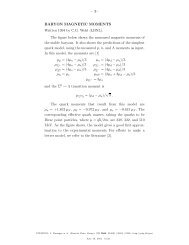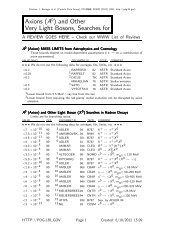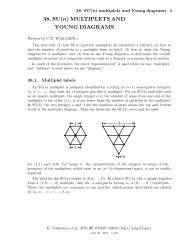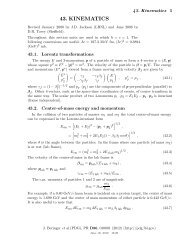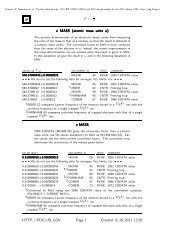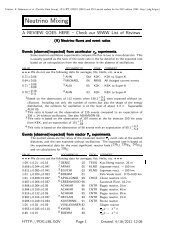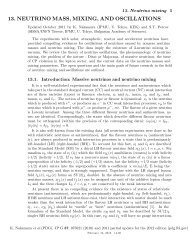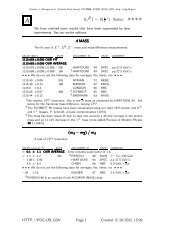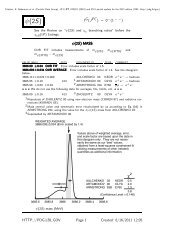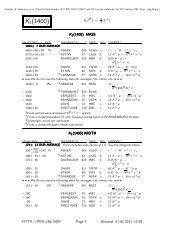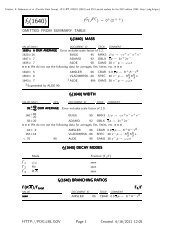Muon Decay Parameters - Particle Data Group
Muon Decay Parameters - Particle Data Group
Muon Decay Parameters - Particle Data Group
Create successful ePaper yourself
Turn your PDF publications into a flip-book with our unique Google optimized e-Paper software.
– 1–<br />
MUON DECAY PARAMETERS<br />
Revised January 2012 by W. Fetscher and H.-J. Gerber (ETH<br />
Zürich).<br />
Introduction: All measurements in direct muon decay, µ − →<br />
e − + 2 neutrals, and its inverse, νµ + e − → µ − + neutral, are<br />
successfully described by the “V -A interaction,” which is a particular<br />
case of a local, derivative-free, lepton-number-conserving,<br />
four-fermion interaction [1]. As shown below, within this<br />
framework, the Standard Model assumptions, such as the V -A<br />
form and the nature of the neutrals (νµ and ¯νe), and hence<br />
the doublet assignments (νe e − )L and (νµ µ − )L, have been determined<br />
from experiments [2,3]. All considerations on muon<br />
decay are valid for the leptonic tau decays τ → ℓ + ντ + ¯νe with<br />
the replacements mµ → mτ, me → mℓ.<br />
<strong>Parameters</strong>: The differential decay probability to obtain an<br />
e ± with (reduced) energy between x and x + dx, emitted in the<br />
direction x3 at an angle between ϑ and ϑ + dϑ with respect<br />
to the muon polarization vector P µ, and with its spin parallel<br />
to the arbitrary direction ζ, neglecting radiative corrections, is<br />
given by<br />
d 2 Γ<br />
dx d cosϑ<br />
= mµ<br />
4π 3 W 4 eµ G2 F<br />
<br />
x 2 − x 2 0<br />
× (FIS(x) ± Pµ cos ϑ FAS(x))<br />
<br />
× 1 + <br />
ζ · P e(x, ϑ) . (1)<br />
Here, Weµ = max(Ee) = (m2 µ + m2 e)/2mµ is the maximum e ±<br />
energy, x = Ee/Weµ is the reduced energy, x0 = me/Weµ =<br />
9.67 × 10−3 , and Pµ = |P µ| is the degree of muon polarization.<br />
ζ is the direction in which a perfect polarization-sensitive<br />
electron detector is most sensitive. The isotropic part of the<br />
spectrum, FIS(x), the anisotropic part FAS(x), and the electron<br />
polarization, P e(x, ϑ), may be parametrized by the Michel<br />
parameter ρ [1], by η [4], by ξ and δ [5,6], etc. These are<br />
bilinear combinations of the coupling constants g γ εµ, which occur<br />
in the matrix element (given below).<br />
If the masses of the neutrinos as well as x2 0 are neglected,<br />
the energy and angular distribution of the electron in the rest<br />
CITATION: J. Beringer et al. (<strong>Particle</strong> <strong>Data</strong> <strong>Group</strong>), PR D86, 010001 (2012) (URL: http://pdg.lbl.gov)<br />
June 18, 2012 15:23
– 2–<br />
frame of a muon (µ ± ) measured by a polarization insensitive<br />
detector, is given by<br />
d2Γ dx d cosϑ ∼ x2 <br />
· 3(1 − x) + 2ρ<br />
3 (4x − 3) + 3η x0(1 − x)/x<br />
<br />
± Pµ · ξ · cos ϑ 1 − x + 2δ<br />
<br />
(4x − 3) . (2)<br />
3<br />
Here, ϑ is the angle between the electron momentum and the<br />
muon spin, and x ≡ 2Ee/mµ. For the Standard Model coupling,<br />
we obtain ρ = ξδ = 3/4, ξ = 1, η = 0 and the differential decay<br />
rate is<br />
d 2 Γ<br />
dx d cosϑ = G2 F m5 µ<br />
192π 3 [3 − 2x ± Pµ cos ϑ(2x − 1)] x 2<br />
. (3)<br />
The coefficient in front of the square bracket is the total decay<br />
rate.<br />
If only the neutrino masses are neglected, and if the e ±<br />
polarization is detected, then the functions in Eq. (1) become<br />
FIS(x) = x(1 − x) + 2<br />
9 ρ(4x2 − 3x − x 2 0) + η · x0(1 − x)<br />
FAS(x) = 1<br />
3 ξ<br />
<br />
x 2 − x 2 0<br />
× [1 − x + 2δ(4x<br />
− 3 + (<br />
3<br />
<br />
1 − x 2 0<br />
− 1))]<br />
P e(x, ϑ) = PT1 · x1 + PT2 · x2 + PL · x3 . (4)<br />
Here x1, x2, and x3 are orthogonal unit vectors defined as<br />
follows:<br />
x3 is along the e momentum p e<br />
x3 × P µ<br />
|x2 × P µ| = x2 is transverse to p e and perpendicular<br />
to the “decay plane”<br />
x2 × x3 = x1 is transverse to the p e and in the<br />
“decay plane.”<br />
June 18, 2012 15:23
– 3–<br />
The components of P e then are given by<br />
PT1 (x, ϑ) = Pµ sin ϑ · FT1 (x)/ (FIS(x) ± Pµ cosϑ · FAS(x))<br />
PT2 (x, ϑ) = Pµ sin ϑ · FT2 (x)/ (FIS(x) ± Pµ cosϑ · FAS(x))<br />
<br />
PL(x, ϑ) = ±FIP(x) + Pµ cosϑ<br />
<br />
× FAP(x) / (FIS(x) ± Pµ cosϑ · FAS(x)) ,<br />
where<br />
1<br />
FT1 (x) =<br />
12<br />
FT2<br />
(x) = 1<br />
3<br />
FIP(x) = 1<br />
54<br />
FAP(x) = 1<br />
6<br />
<br />
−2 ξ ′′ + 12(ρ − 3<br />
4 )<br />
<br />
(1 − x)x0<br />
−3η(x 2 − x 2 0) + η ′′ (−3x 2 + 4x − x 2 0) <br />
<br />
x2 − x2 <br />
0 3 α′<br />
<br />
(1 − x) + 2β′ 1 − x<br />
A A<br />
2 <br />
0<br />
<br />
<br />
−2x + 2 +<br />
<br />
x2 − x2 <br />
0 9ξ ′<br />
<br />
1 − x2 0<br />
<br />
1 − x2 0 )<br />
<br />
+ 4ξ(δ − 3)(4x<br />
− 4 +<br />
4<br />
<br />
ξ ′′ (2x 2 − x − x 2 3<br />
0 ) + 4(ρ −<br />
4 ) 4x 2 − 3x − x 2 <br />
0<br />
+2η ′′ <br />
(1 − x)x0 . (5)<br />
For the experimental values of the parameters ρ, ξ, ξ ′ , ξ ′′ , δ,<br />
η, η ′′ , α/A, β/A, α ′ /A, β ′ /A, which are not all independent,<br />
see the <strong>Data</strong> Listings below. Experiments in the past have also<br />
been analyzed using the parameters a, b, c, a ′ , b ′ , c ′ , α/A, β/A,<br />
α ′ /A, β ′ /A (and η = (α − 2β)/2A), as defined by Kinoshita<br />
and Sirlin [5,6]. They serve as a model-independent summary<br />
of all possible measurements on the decay electron (see Listings<br />
below). The relations between the two sets of parameters are<br />
ρ − 3<br />
4<br />
3 = (−a + 2c)/A ,<br />
4<br />
η = (α − 2β)/A ,<br />
η ′ ′ = (3α + 2β)/A ,<br />
δ − 3<br />
4<br />
= 9<br />
4 ·<br />
(a ′ − 2c ′ )/A<br />
1 − [a + 3a ′ + 4(b + b ′ ) + 6c − 14c ′ ]/A ,<br />
1 − ξ δ<br />
ρ = 4 [(b + b′ ) + 2(c − c ′ )]/A<br />
1 − (a − 2c)/A<br />
1 − ξ ′ = [(a + a ′ ) + 4(b + b ′ ) + 6(c + c ′ )]/A ,<br />
1 − ξ ′ ′ = (−2a + 20c)/A ,<br />
June 18, 2012 15:23<br />
,
where<br />
– 4–<br />
A = a + 4b + 6c . (6)<br />
The differential decay probability to obtain a left-handed νe with<br />
(reduced) energy between y and y + dy, neglecting radiative<br />
corrections as well as the masses of the electron and of the<br />
neutrinos, is given by [7]<br />
dΓ<br />
dy = m5 µ G2 F<br />
16π3 · Q νe<br />
L<br />
· y2(1<br />
− y) − ωL · (y − 3<br />
4 )<br />
<br />
. (7)<br />
Here, y = 2 Eνe/mµ. Q νe<br />
L and ωL are parameters. ωL is the<br />
neutrino analog of the spectral shape parameter ρ of Michel.<br />
Since in the Standard Model, Q νe<br />
L = 1, ωL = 0, the measurement<br />
of dΓ/dy has allowed a null-test of the Standard Model<br />
(see Listings below).<br />
Matrix element: All results in direct muon decay (energy<br />
spectra of the electron and of the neutrinos, polarizations,<br />
and angular distributions), and in inverse muon decay (the<br />
reaction cross section) at energies well below mWc 2 , may be<br />
parametrized in terms of amplitudes g γ εµ and the Fermi coupling<br />
constant GF, using the matrix element<br />
4GF<br />
√2<br />
<br />
γ=S,V,T<br />
ε,µ=R,L<br />
g γ εµ〈ēε|Γ γ |(νe)n〉〈(¯νµ)m|Γγ|µµ〉. (8)<br />
We use the notation of Fetscher et al. [2], who in turn use the<br />
sign conventions and definitions of Scheck [8]. Here, γ = S, V, T<br />
indicates a scalar, vector, or tensor interaction; and ε, µ = R, L<br />
indicate a right- or left-handed chirality of the electron or muon.<br />
The chiralities n and m of the νe and ¯νµ are then determined<br />
by the values of γ, ε, and µ. The particles are represented by<br />
fields of definite chirality [9].<br />
As shown by Langacker and London [10], explicit leptonnumber<br />
nonconservation still leads to a matrix element equivalent<br />
to Eq. (8). They conclude that it is not possible, even in<br />
principle, to test lepton-number conservation in (leptonic) muon<br />
decay if the final neutrinos are massless and are not observed.<br />
The ten complex amplitudes g γ εµ (gT RR and gT LL are identically<br />
zero) and GF constitute 19 independent (real) parameters<br />
June 18, 2012 15:23
– 5–<br />
to be determined by experiment. The Standard Model interaction<br />
corresponds to one single amplitude gV LL being unity and<br />
all the others being zero.<br />
The (direct) muon decay experiments are compatible with<br />
an arbitrary mix of the scalar and vector amplitudes gS LL and<br />
gV LL – in the extreme even with purely scalar gS LL = 2, gV LL = 0.<br />
The decision in favour of the Standard Model comes from the<br />
quantitative observation of inverse muon decay, which would be<br />
forbidden for pure gS LL [2].<br />
Experimental determination of V –A: In order to determine<br />
the amplitudes g γ εµ uniquely from experiment, the following<br />
set of equations, where the left-hand sides represent<br />
experimental results, has to be solved.<br />
and<br />
a = 16(|g V RL |2 + |g V LR |2 ) + |g S RL + 6gT RL |2 + |g S LR + 6gT LR |2<br />
a ′ = 16(|g V RL |2 − |g V LR |2 ) + |g S RL + 6gT RL |2 − |g S LR + 6gT LR |2<br />
<br />
α = 8Re<br />
α ′ = 8Im<br />
g V RL (gS∗<br />
LR<br />
∗<br />
+ 6gT LR ) + gV LR (gS∗<br />
∗<br />
RL + 6gT RL )<br />
<br />
g V LR (gS∗<br />
∗<br />
RL + 6gT RL ) − gV RL (gS∗<br />
∗<br />
LR + 6gT LR )<br />
b = 4(|g V RR |2 + |g V LL |2 ) + |g S RR |2 + |g S LL |2<br />
b ′ = 4(|g V RR |2 − |g V LL |2 ) + |g S RR |2 − |g S LL |2<br />
β = −4Re<br />
β ′ = 4Im<br />
<br />
Q νe<br />
L<br />
c = 1<br />
2<br />
c ′ = 1<br />
2<br />
= 1 −<br />
ωL = 3<br />
4<br />
<br />
g V RR gS∗<br />
LL + gV LL gS∗<br />
RR<br />
<br />
g V RR gS∗<br />
LL − gV LL gS∗<br />
RR<br />
|g S RL − 2gT RL |2 + |g S LR − 2gT LR |2<br />
<br />
|g S RL − 2gT RL |2 − |g S LR − 2gT LR |2<br />
<br />
<br />
1<br />
4 |gS LR |2 + 1<br />
4 |gS LL |2 + |g V RR |2 + |g V RL |2 + 3|g T LR |2<br />
{|g S RR |2 + 4|g V LR |2 + |g S RL + 2gT RL |2 }<br />
|g S RL |2 + |g S RR |2 + 4|g V LL |2 + 4|g V LR |2 + 12|g T RL |2 } .<br />
It has been noted earlier by C. Jarlskog [11], that certain experiments<br />
observing the decay electron are especially informative<br />
if they yield the V -A values. The complete solution is now<br />
found as follows. Fetscher et al. [2] introduced four probabilities<br />
June 18, 2012 15:23
– 6–<br />
Qεµ(ε, µ = R, L) for the decay of a µ-handed muon into an<br />
ε-handed electron, and showed that there exist upper bounds<br />
on QRR, QLR, and QRL, and a lower bound on QLL. These<br />
probabilities are given in terms of the g γ εµ’s by<br />
Qεµ = 1<br />
4 |gS εµ |2 + |g V εµ |2 + 3(1 − δεµ)|g T εµ |2 , (9)<br />
where δεµ = 1 for ε = µ, and δεµ = 0 for ε = µ. They are<br />
related to the parameters a, b, c, a ′ , b ′ , and c ′ by<br />
QRR = 2(b + b ′ )/A ,<br />
QLR = [(a − a ′ ) + 6(c − c ′ )]/2A ,<br />
QRL = [(a + a ′ ) + 6(c + c ′ )]/2A ,<br />
QLL = 2(b − b ′ )/A , (10)<br />
with A = 16. In the Standard Model, QLL = 1 and the others<br />
are zero.<br />
Since the upper bounds on QRR, QLR, and QRL are found<br />
to be small, and since the helicity of the νµ in pion decay is<br />
known from experiment [12,13] to very high precision to be<br />
−1 [14], the cross section S of inverse muon decay, normalized<br />
to the V -A value, yields [2]<br />
and<br />
|g S LL |2 ≤ 4(1 − S) (11)<br />
|g V LL |2 = S . (12)<br />
Thus the Standard Model assumption of a pure V -A leptonic<br />
charged weak interaction of e and µ is derived (within errors)<br />
from experiments at energies far below mass of the W ± :<br />
Eq. (12) gives a lower limit for V -A, and Eqs. (9) and (11)<br />
give upper limits for the other four-fermion interactions. The<br />
existence of such upper limits may also be seen from QRR +<br />
QRL = (1 − ξ ′ )/2 and QRR + QLR = 1(1<br />
+ ξ/3 − 16 ξδ/9).<br />
2<br />
Table 1 gives the current experimental limits on the magnitudes<br />
of the g γ εµ’s. More stringent limits on the six coupling constants<br />
gS LR , gV LR , gT LR , gS RL , gV RL , and gT RL have been derived from<br />
upper limits on the neutrino mass [18]. Limits on the “charge<br />
June 18, 2012 15:23
– 7–<br />
retention” coordinates, as used in the older literature (e.g.,<br />
Ref. 19), are given by Burkard et al. [20].<br />
Table 1. Coupling constants g γ εµ and some combina-<br />
tions of them. Ninety-percent confidence level experi-<br />
| are from<br />
mental limits. The limits on |gS LL | and |gV LL<br />
Ref. 15, and the others from a general analysis of muon<br />
decay measurements. Top two rows: Ref. 22, next two<br />
rows: Ref. 16, bottom three rows: Ref. 17, last row:<br />
Ref. 21. The experimental uncertainty on the muon<br />
polarization in pion decay is included. Note that, by<br />
definition, |gS εµ| ≤ 2, |gV εµ| ≤ 1 and |gT εµ| ≤ 1/ √ 3.<br />
|gS RR | < 0.035 |gV RR | < 0.017 |gT RR | ≡ 0<br />
|gS LR | < 0.050 |gV LR | < 0.023 |gT LR | < 0.015<br />
|gS RL | < 0.412 |gV RL | < 0.104 |gT RL | < 0.103<br />
|gS LL | < 0.550 |gV LL | > 0.960 |gT LL | ≡ 0<br />
|gS LR + 6gT LR | < 0.143 |gS RL + 6gT RL | < 0.418<br />
|gS LR + 2gT LR | < 0.108 |gS RL + 2gT RL | < 0.417<br />
|gS LR − 2gT LR | < 0.070 |gS RL − 2gT RL | < 0.418<br />
QRR + QLR < 8.2 × 10 −4<br />
References<br />
1. L. Michel, Proc. Phys. Soc. A63, 514 (1950).<br />
2. W. Fetscher, H.-J. Gerber, and K.F. Johnson, Phys. Lett.<br />
B173, 102 (1986).<br />
3. P. Langacker, Comm. Nucl. Part. Phys. 19, 1 (1989).<br />
4. C. Bouchiat and L. Michel, Phys. Rev. 106, 170 (1957).<br />
5. T. Kinoshita and A. Sirlin, Phys. Rev. 107, 593 (1957).<br />
6. T. Kinoshita and A. Sirlin, Phys. Rev. 108, 844 (1957).<br />
7. W. Fetscher, Phys. Rev. D49, 5945 (1994).<br />
8. F. Scheck, in Electroweak and Strong Interactions (Springer<br />
Verlag, 1996).<br />
9. K. Mursula and F. Scheck, Nucl. Phys. B253, 189 (1985).<br />
10. P. Langacker and D. London, Phys. Rev. D39, 266 (1989).<br />
11. C. Jarlskog, Nucl. Phys. 75, 659 (1966).<br />
12. A. Jodidio et al., Phys. Rev. D34, 1967 (1986);<br />
A. Jodidio et al., Phys. Rev. D37, 237 (1988).<br />
13. L.Ph. Roesch et al., Helv. Phys. Acta 55, 74 (1982).<br />
14. W. Fetscher, Phys. Lett. 140B, 117 (1984).<br />
June 18, 2012 15:23
– 8–<br />
15. S.R. Mishra et al., Phys. Lett. B252, 170 (1990);<br />
S.R. Mishra, private communication;<br />
See also P. Vilain et al., Phys. Lett. B364, 121 (1995).<br />
16. R.P. MacDonald et al., Phys. Rev. D78, 032010 (2008).<br />
17. C.A. Gagliardi, R.E. Tribble, and N.J. Williams, Phys.<br />
Rev. D72, 073002 (2005).<br />
18. G. Prézeau and A. Kurylov, Phys. Rev. Lett. 95, 101802<br />
(2005).<br />
19. S.E. Derenzo, Phys. Rev. 181, 1854 (1969).<br />
20. H. Burkard et al., Phys. Lett. 160B, 343 (1985).<br />
21. R. Bayes et al., Phys. Rev. Lett. 106, 041804 (2011).<br />
22. A. Hillairet et al., Phys. Rev. D85, 092013 (2012).<br />
June 18, 2012 15:23



